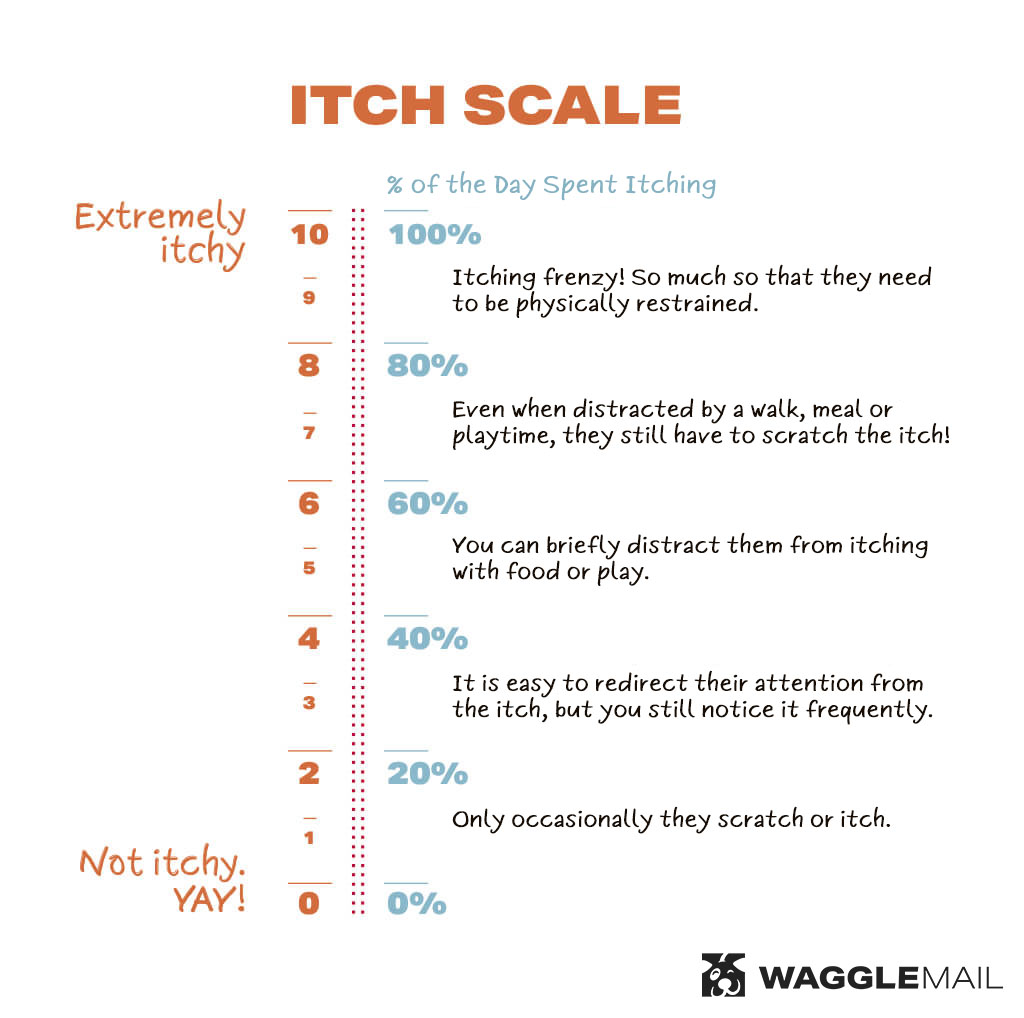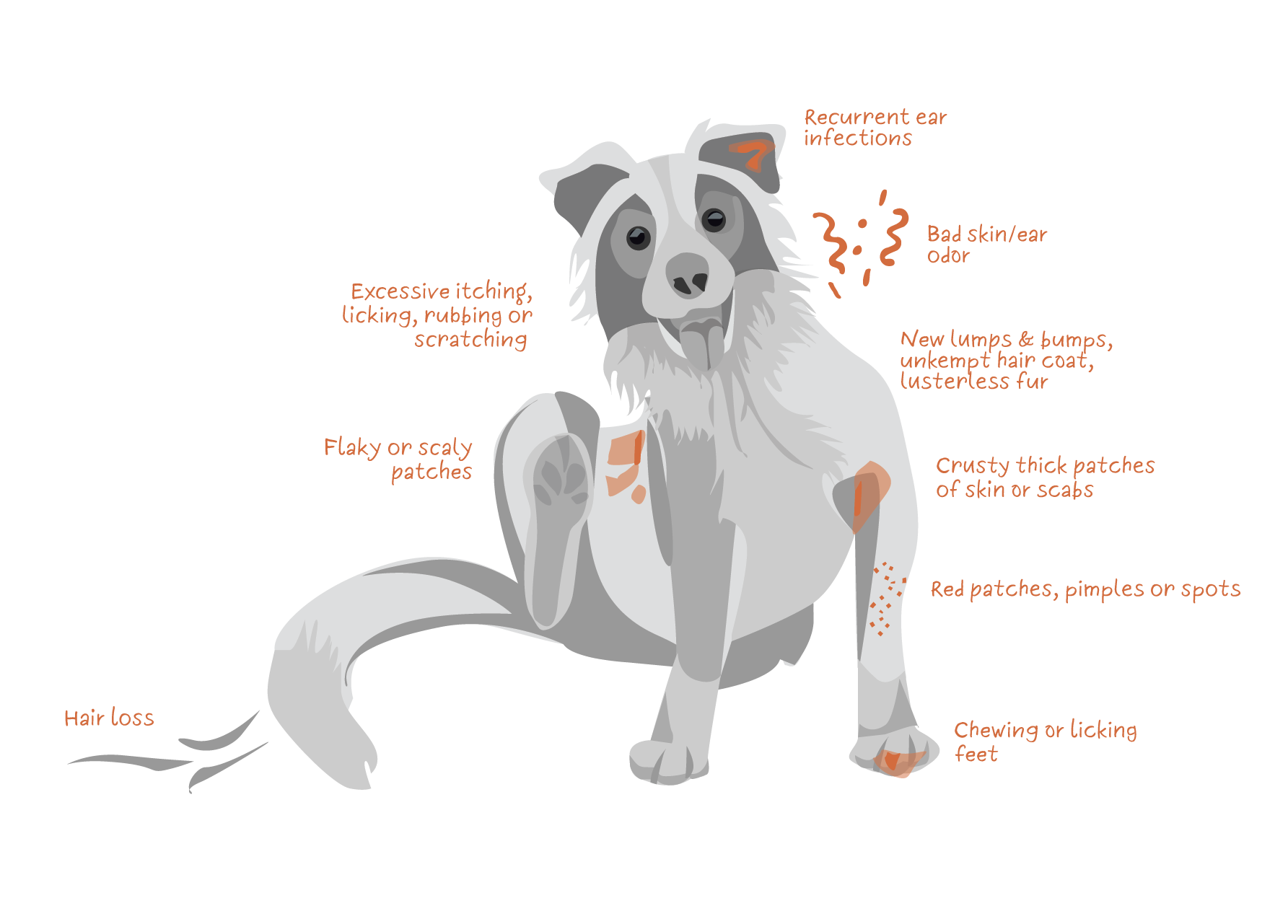The Pet Parent’s Guide to Dog Allergies (Part III): Food Allergies
If you’ve been following along with our dog allergies series—part of our company-wide promise to educate and empower pet parents—you’ll know the difference between allergies and allergens. You’ll also know that most allergies come in two forms: environmental allergies (atopic dermatitis) and food allergies (cutaneous adverse food reactions or CAFR).
On the menu for today: food allergies in dogs.
In this post you’ll find information about what can trigger an allergic response, signs and symptoms of a possible food allergy, and what options are at your disposal to help your dog feel better… even when you’re not sure of the source of their misery.
What are food allergies in dogs?
Food allergies are skin-associated abnormal responses to food. They can present as an immune reaction (a food allergy or food hypersensitivity) or a non-immune-related response (a food intolerance) to a dietary component—be it a carbohydrate, a protein, or something else.
Known in veterinary circles as cutaneous adverse food reactions (CAFRs), these responses are still somewhat mysterious in that how they develop in dogs is not fully understood. However, the following four factors are generally considered the top predictors of a food allergy:
- Diet
- Genetics
- Concurrent health status
- Immune status
What we do know about food allergies in dogs is that they can develop at a young age (and at any age, for that matter). According to literature, between 22-38% of dogs exhibit symptoms consistent with a food allergy before their first birthday. Of those dogs with food allergies, approximately one third present with environmental allergies, too. (Quite the double whammy.)
We’re often asked whether certain breeds are more likely to develop food allergies. The jury is still out on this, but there is research to support that breeds such as German Shepherds, West Highland White Terriers, and Labrador Retrievers tend to get the short end of the stick when it comes to food-related sensitivities.
Signs and symptoms of food allergies in dogs
Allergies are one of the top reasons dogs experience inflammation and itchy skin and ears.
Severe itchiness (also known as pruritis) is the hallmark symptom of food allergies in dogs, but how will you know when that itch needs to be scratched?
We developed this Waggle Mail Itch Scale to help you track your dog’s itchiness. By documenting when your dog seems itchier, what medications you’re administering when, and what types of food or treats they’re being fed may put you on a fast-track to beating the itch.

Unlike environmental allergies, vomiting, diarrhea, and frequent bowel movements (more than 2-3 times per day) are common non-skin-related symptoms.
You’ll also want to be on the lookout for signs such as:
- Recurrent ear infections
- Chewing or licking feet
- Excessive itching, licking, rubbing, or scratching
- Stinky skin or ears
- Hair loss
- Red patches, pimples, or spots on the skin
- Crusty, thick patches of skin or scabs
- Flaky or scaly patches of skin
We’ve summed up some of the most common food allergy symptoms for you here:

If you’re wondering when an itch truly deserves a scratch, we’ve got a solution for that, too.
Are there specific foods that cause food allergies in dogs?
Yes and no.
While there are some common culprits (beef, dairy, chicken, wheat, and lamb), how and whether your dog will react to a particular dietary component can’t be reliably predicted. Unfortunately, most times it’s a trial by fire.
Psst—if you haven’t already heard, Waggle Mail dog subscription boxes are curated based on the information you provide about your dog. If your dog has a known or suspected dairy allergy, you can sleep easy knowing the treats and chews we include in your subscription will be allergen-free.
Diagnosing food allergies in dogs
If you’ve noticed your dog itching and scratching more than usual, you might think the next move is to book in with your family veterinarian to discuss diagnostic options. Although it’s never a bad idea to consult with a vet, we recommend taking time before you pick up the phone to put together a food history log (or what some might call a “dietary digest”).
In this digest you’ll list any and all proteins they’ve eaten recently (for example, chicken, beef, or salmon), as well as any special treats or supplements, dental chews, oral dewormers, flavoured medications, and so on. Honesty is the best policy when it comes to this log: the more transparent you are about whether you sneak your dog a few table scraps at night, the better equipped your vet is to efficiently tackle the issue.
Armed with as much information as you can source (the more, the better), you and your vet will work together to develop and refine an individualized action plan. We mentioned this in our first dog allergy instalment, but it’s worth restating: most veterinarians will build a plan that is carried out in stages based on your dog’s history and any physical exam findings.
Before diagnosis comes relief
In our earlier instalments we discussed at length the first few steps of the diagnostic journey (ruling out other major causes of itching, for example). Because this is not an overnight process—far from it, in some cases—it’s important to stay the course and keep relief top of mind. Sometimes, a short-term solution is necessary to keep your pet from itching themselves into a frenzy and compounding the issue with other developing medical or health concerns.
Contrary to popular belief, you cannot diagnose a food allergy through the commercially-available blood, saliva and hair tests you may have been served ads for on social media. The only (and therefore best) way to accurately diagnose CAFRs is from a positive response to a food trial, otherwise known as an elimination diet trial or EDT.
What’s the best diet for an elimination diet trial (EDT)?
Despite what you might see or hear online, there is no universally effective diet for food trials because no dietary protein is naturally hypoallergenic for all dogs. Instead, you’ll work with your vet to choose a diet that is compatible with your dog’s dietary history and your lifestyle (plant-based, for example).
Broadly speaking, there are two types of appropriate test diets:
- Novel protein diets (limited antigen diets that expose your dog to new, never-ingested proteins)
- Hydrolyzed protein diets (special diets where the proteins have been broken down into smaller fragments, making them more digestible and less likely to cause an allergic response)
Sure, you might find decent dog foods at your local pet store, but when it comes to food trials it’s worth being a food snob. Unlike many over-the-counter diets, vet-prescribed diets means it will have been tested for cross-contamination and can therefore live up to any allergen-free claims on the label.
Your next step after selecting a diet is, of course, to test it. Next, we’ll explain what that looks like (and what not to do).
How to do an elimination diet trial
An EDT is sometimes referred to as a strict food trial. Why strict? Because much like a test at school, there is no cheating allowed. No matter how good your dog is at guilting you with those sweet, wishful puppy eyes, this is not the time for treats or table scraps. Even the smallest slip-up can land you back at square one.
Not surprisingly, EDTs require a lot of patience, perseverance, and open communication with anyone who comes in contact with your dog.
You’ll carry out your food trial in three steps:
Step 1: Give your chosen food (and only your chosen food) for 8 full weeks.
This first step is non-negotiable with no exceptions. No fruits, veggies, chews, flavoured supplements—nada.
Understandably, this step is intimidating; even a tiny piece of cheese means the clock starts back at zero. However, just because it’s intimidating doesn’t mean it’s impossible.
Here are some tips to help you through this painful-yet-possible process:
- Using a prescribed topical dewormer instead of a flavoured alternative
- Keeping your dog away from the table at mealtimes
- Running your trial over the winter months when there are fewer allergens around that might induce symptoms and confuse your progress
- Using their special food as treats. Most dry foods will also come in a canned form that can be baked, frozen, or used in treat toys for a stimulating (and satiating) afternoon activity
Step 2: Throw a one-night rager and reintroduce all their favourite foods.
This may sound crazy, but trust us: it’s part of the process. Throwing a food party means you’re challenging your dog’s systems to see what they’re actually allergic to (also known as ruling in food allergies). If they relapse (become itchy again), you’ll know something’s up and revert back to your dog’s special diet for relief.
Step 3: Provoke and pick out allergies one by one.
With your dog safely back on their prescribed diet, it’s now time to test ingredients one by one.
Remember that doggy digest we talked about earlier? That’s an excellent resource to keep handy as you challenge and assess individual ingredients.
Here’s how it works: first, you’ll offer the ingredient and then you’ll play the waiting game. Sometimes your dog will start itching within hours; other times it will take between 3-5 days. We recommend monitoring for a minimum of two weeks. If, after the two weeks, there are no signs or symptoms of a food allergy, move on to the next.
Other treatments for dog allergies triggered by food
Because food trials are a months-long process, your vet may prescribe one or more of the following to alleviate the itch as you experiment with different foods:
- Antihistamines or anti-inflammatory medications
- Effective and safe oral or topical supplements
- Prescription medications or treatments (antibiotics, anti-fungals, leave-on products, ectoparasite treatments)
- Medicated baths or showers
There’s no two ways around it: allergies are irritating (for you and your dog). Choosing treats and topicals can become a source of stress and anxiety because, of course, you don’t want to choose the wrong thing and be responsible for a symptom flare-up.
If your dog has suspected or confirmed allergies (or develops them with age), we have good news: Waggle Mail dog subscription boxes are adaptable and allergy-friendly. Join our pack, ease your mind, and please your pup.
Want more Waggle? Subscribe to Waggle (e)Mail. Like our subscription boxes, our emails are purpose full and filler free. We treat pack members to early access to exclusive offers, round-ups of recent blog posts, and other fun ways to promote a healthy body, healthy mind, and healthy pet-parent bond.


